 |
|

|
 |
TABLE of CONTENTS
 |
New MnPASS lanes are open on Interstate 35E |
By Bobbie Dahlke, MnPASS communications coordinator
This video describes the new MnPASS lanes on Interstate 35E between Little Canada Road and County Road J. Video courtesy of the MnPASS project |
Construction on the new MnPASS lanes on Interstate 35E between St. Paul and White Bear Lake is complete and commuters in the northeast Twin Cities metro got to use the new MnPASS lanes before the first snow storm in December.
Under construction since spring 2016, the new MnPASS lanes between Little Canada Road and County Road J look and operate differently than other MnPASS lanes.
Between 6 a.m. and 10 a.m. Monday through Friday, the southbound MnPASS lane designation begins at County Road 96. The MnPASS designation continues through the I-35E/I-694 commons area using an existing left lane.
Between 3 p.m. and 7 p.m. Monday through Friday, the northbound MnPASS lane designation begins at Cayuga Street and ends at Little Canada Road. An overhead Express Restriction Ends sign alerts motorists that the northbound MnPASS lane becomes a general purpose lane through the I-35E/694 commons area and is open to all motorists. At County Road E, the left lane becomes a MnPASS lane and is restricted to transit, vehicles with two or more occupants (HOV 2+) and solo motorists with a MnPASS tag. The lane becomes a general purpose lane at County Road J in White Bear Lake.
Constructing a hybrid approach that drops the MnPASS lane designation through the I-35E/I-694 interchange in one direction and carries it through the interchange in the opposite direction is an innovative approach to managing congestion and is a first for MnDOT.
The concept was a result of MnPASS Extension study that examined the feasibility of extending existing MnPASS lanes at Little Canada Road to the north. A goal of the study was to provide a MnPASS option that reduced congestion for all users, including drivers in the general-purpose traffic lanes and transit users. The study showed a hybrid approach significantly improved the flow of traffic during peak travel times and produced the highest benefit. MnDOT traffic operations will monitor the flow of traffic through the I-35E/694 interchange to see if the hybrid approach affects traffic.
“The MnPASS Extension Study analyzed several options for managing congestion in the northeastern Metro and through the I-35W/I-694 interchange," said Brad Larsen, MnPASS Policy and Planning Program director. "A hybrid approach significantly improves traffic and facilitates greater transit, carpool and vanpool use along the entire I-35E corridor."
MnPASS is Minnesota’s system of priced managed lanes and often referred to as High Occupancy Toll lanes. Priced managed lanes provide a congestion-free travel option during peak travel times by pricing specific lanes at rates that maintain free flow conditions for all commuters. The lanes are free and can be used by all motorists before and after peak travel times.
MnPASS is a strategy for managing and reducing congestion on some of Minnesota's busiest highways. It is not a strategy to generate revenue. The MnPASS transportation system:
- Increases the number of people who are moved through a corridor during peak travel times
- Provides a reliable, congestion-free travel choice for commuters
- Improves public transit service and ridership
- Increases carpools and vanpools
Motorists who enroll in the MnPASS program before Jan. 31 will receive $15 in commute credits. More information is available on the new MnPASS website, www.mnpass.org. |
 |
|

|
 |
TABLE of CONTENTS
 |
Tow plows help make quick work of winter cleanup |
By Sue Roe
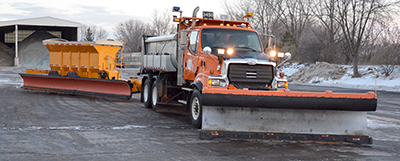
The Lakeville subarea of the Metro District has one tow plow. The truck features a front end plow, salt/sand hopper and tailgate sander. The tow plow can be moved to the right side to plow an additional travel lane. The tow plow has a hopper for salt or sand that is dispersed via a spinner located underneath the tow plow trailer. Photo by Sue Roe |
MnDOT has a good arsenal when it comes to fighting winter. There’s the fleet of 800-plus snowplows. There are chemicals that effectively treat and clear roadways. There’s the sophisticated technology, such as the Road Weather Information System, Maintenance Decision Support System and the Automated Vehicle Location system, that helps MnDOT make good decisions about what materials to use at the right time in the right quantity in the right place.
And then there are tow plows.
MnDOT has used tow plows for about 10 years, but the addition of six more this winter season brings a big boost to winter maintenance operations.
This 50,600 pound piece of equipment, when hooked to the back of a 48,000 pound tandem axle snowplow, clears a path in excess of 28 feet wide, equivalent to two lanes of travel plus four feet.
“People definitely notice our tow plow out on the road. We can use it anywhere. We can plow a ramp with one pass and clear more road in one pass. It’s an amazing piece of equipment,” said Rob Hendel, supervisor in the Lakeville subarea of the Metro District.
The operator moves the plow to the right side of the truck with a pull of a lever from inside the cab, often making the 70-foot long truck and plow appear jackknifed as it travels down the road.
It works similar to a wing plow, only with greater reach, said Hendel.
“That’s the best thing about the tow plow. Operators can clear that much more snow in a single pass,” said Chris Cheney, D1 maintenance operations supervisor.
In bigger storms, the tow plow truck is sometimes used in tandem with two other standard snowplows. One plow in back of the tow plow clears the right shoulder and the plow in front clears the left shoulder. There is a two-foot overlap between the tow plow and second plow.
The truck is specially-built to include extra hydraulics and electrical components, including extra operator controls. It’s equipped with a salt or sand hopper and tailgate sander, so plowing, salting and sanding can be performed as needed without an additional truck or a return to the truck station. Some districts use a liquid tank instead of a hopper.
The trailer that holds the tow plow can also hold an additional tank for liquids.
“Tow plows work so well in the Duluth area that we’ll have a third one in the south subarea next year,” said Cheney. “The sooner you can put ‘iron on the ground’ and the longer you can keep it out there, the less compaction develops. That reduces the salt usage while keeping roads in good driving condition.”
This video shows MnDOT’s tow plows in action on Minnesota roadways. Video produced by Rich Kemp and Video Services |
These efficiencies mean big savings for winter maintenance operations.
In fiscal year 2015, tow plows saved MnDOT $490,000 in labor, maintenance, fuel and equipment costs. In fiscal year 2016, with the additional six tow plows, the savings increased to $680,000.
Tow plows cost approximately $130,000, about half the cost of a standard truck, but the annual savings from having one tow plow is $38,000 per 2,000 lane miles traveled. That’s $19 less per lane mile than an additional plow truck.
“A tow plow gives us extra capability to improve snow and ice operations and optimize our equipment spending,” said Sue Lodahl, assistant state maintenance engineer.
MnDOT now has 20 tow plows in seven districts.
“I look at having a tow plow in our shop as a big bonus,” said Hendel. “It means having one more truck to help elsewhere and it makes snow and ice operations easier for our crew.”
Hendel said two workers in his shop are trained to drive the tow plow, but there are four others being trained.
“Operators like to drive the tow plow. It takes time to develop those skills. There are more who want to be trained,” he said.
Learn about driving safely around snowplows.
Other types of plows MnDOT uses:
• Front end plows - the most common type of plow; the blade is attached to the front end of the truck
• Wing plows - push snow and ice to the side and are often used with other plow types; the blade can be positioned at the truck’s front, middle or rear.
• Underbody plows - aid during snow compaction; they are located behind the front wheels to exert down-pressure. They can be used by themselves or with a front plow for optimal clearing.
• Other snow fighting equipment includes motor graders with wing plow attachments, dump trucks with underbody or front plows and a material spreader, and trucks with blowers.
|
|
 |
|

|
|

|
 |
TABLE of CONTENTS
 |
WIG 2.0 Spotlight: Workforce Focus Area strives to create more diverse work environment |
By Judy Jacobs
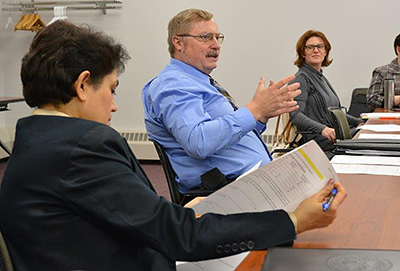
Mike Barnes, champion for the WIG 2.0 Workforce focus area, leads a recent Workforce Advisory Committee meeting at Arden Hills. Photo by Judy Jacobs |
More than 600 WIG 2.0 teams and nearly 5,000 MnDOT employees across the state are working on ways to improve customer engagement and advance equity in the agency. An important component of these efforts is to close the gaps in the diversity of MnDOT's workforce so 100 percent of the job categories of service maintenance, skilled craft, technicians, clerical and professional match the availability of women, minorities and people living with a disability within the available state workforce.
“Minnesota is consistently recognized as one of the best states in which to live, work and raise a family. And, MnDOT contributes directly to the overall health, well-being and quality of life many Minnesotans enjoy,” said Eric Davis, chief of staff, and member of the Workforce Executive team. “However, too many people find themselves left out and falling further behind, particularly among populations of color, women and people living with a disability. The present economic and health disparities in Minnesota are some of the worst in the country.”
The state uses the following U.S. Equal Employment Opportunity Commission job categories: service maintenance, skilled craft, technicians, clerical, professionals and administrators for their affirmative action plans. These laws, regulations and plans identify state employment goals for women, racial and ethnic minorities and people living with a disability.
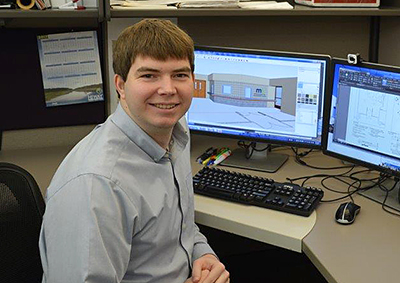
Andrew Palmberg, Central Office Building Services, has been working with MnDOT for nearly five years. Photo by Judy Jacobs |
Andrew Palmberg, architectural drafter and Americans with Disabilities Act specialist, Central Office Building Services, joined MnDOT about five years ago. He was hired through a referral from the Department of Employment and Economic Development vocational rehabilitation program, which helps people with a disability find a job. Palmberg was originally hired to inspect all 136 airport terminal facilities in Minnesota for building code accessibility issues. He was conducting an airport accessibility survey in the field when he met Mike Barnes. Barnes was impressed with Palmberg’s passion for architecture and helped him navigate the hiring process.
“I enjoy having the opportunity to work on MnDOT architectural projects that improve and increases accessibility for all state workers and members of the public who use our facilities,” Palmberg said.
His advice on how to make the workplace more accessible?
“Promote more interaction and education about all kinds of disabilities that people have, how they face their disabilities, and what it's like being in their shoes.”
Check out Palmberg in the video The Electronic Curb Cut, produced by The Commission of Deaf, DeafBlind and Hard of Hearing Minnesotans, The Office of Enterprise Technology.
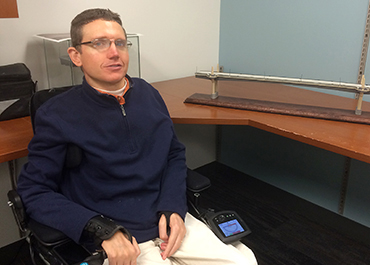
District 6’s Chad Hanson serves as project manager for the Red Wing Bridge project. Photo by Mike Dougherty |
In District 6, Chad Hanson, Red Wing bridge project manager, a 15-year veteran with MnDOT thinks the best part of his job is the variety in projects and challenges that he is involved with.
“All of the projects that I manage are unique so I get involved with many different areas of MnDOT,” Hanson said. “There are always new and specific issues with each project and even though many of them can be challenging I feel like I am always learning.”
Hanson feels that MnDOT has been very good about providing any special equipment or other needs that help him do his job better.
“My biggest challenges are on the projects that I work on every day as opposed to physical challenges,” said Hanson. “Bringing the different internal and external partners and interests together to move projects forward can at times be the most difficult part of my job. There are probably certain things that I physically do differently than others that I work with, but I don’t really think of them as major challenges.”
Hanson’s advice on how to make the workplace more inclusive?
“From my standpoint I see that as just continuing to be inclusive like it already is,” Hanson said. “There are always certain things such as a door opener not working, rooms being too tight to get around, or other things that most people don’t even realize are an issue. Pointing these things out to coworkers helps people realize how they can create obstacles.”
WCCO TV recently featured Hanson in an interview concerning his work on the Red Wing bridge project.
“MnDOT is not hiring enough women, minorities and people living with a disability in half of these job categories,” said Barnes. “Through our efforts in the Workforce focus area, we will work to change that and create a more equitable, and inclusive, workforce.”
To accomplish this, three key goal areas of recruitment, retention and training have been established:
Recruitment
Karin van Dyck, director of Human Resources, is the champion for the Recruitment goal area.
“Our work in this area will allow MnDOT to increase the percentage of targeted group candidates in applicant pools matching the availability of the external Minnesota workforce and expand the number of key referral sources statewide,” she said.
Employees are encouraged to work on growing the number of targeted applicants for MnDOT positions that are available.
Retention
“Our goal is to increase the percentage of full-time, unlimited employees who have completed a career retention interview and a development plan with their supervisor,” said Davis, filling in for Rosemarie Merrigan, champion of the retention goal area. “We are exploring ways to retain employees from targeted groups remain in these positions.”
Training
Linda Hinrichs, serves as champion for the Training goal area.
“Training is the tool that will allow MnDOT to become a more culturally competent workforce,” said Hinrichs. “Employees who have taken MnDOT’s Diversity and Inclusion classes have found them to be unique and very helpful.”
MnDOT offers a variety of classes to help employees build skills in cultural competency. The Workforce Executive Committee includes Mike Barnes, Eric Davis, Karin van Dyck, Betsy Parker, Linda Hinrichs, Rosemarie Merrigan and Judy Jacobs. The committee has been meeting to explore ways to expand the number of classes offered, and increase attendance at training sessions to ensure that employees interested in training have an opportunity to participate.
In addition, a Workforce Advisory Committee, staffed with employees from across the state and led by Barnes, has been established to further explore opportunities to advance equity in the agency and eliminate disparities statewide.
“Our future success as an agency depends on the ability to close these gaps,” Barnes said. “This is a large opportunity we have been missing, but with everyone’s awareness, support, and commitment it is very achievable. When we eliminate these gaps, we will increase customer trust both internally and externally by those in underserved communities.” |
 |
|

|
 |
TABLE of CONTENTS
 |
Transitioning to MnDOT's new logo continues |
|
By Kay Korsgaard
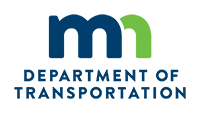
The transition to the new logo began in December 2016 and will take several months. |
It's been a little over a month since MnDOT made the first big steps towards implementing our new logo and brand. MnDOT is among a handful of agencies to take the lead on moving to a new logo that will unite state agencies and help our customers see state government as working together to provide services to the people of Minnesota. Visit http://mn.gov/portal/brand to learn more about this governor's initiative.
The first step included replacing the logo and updating the font and colors on MnDOT's external website, replacing the logo on iHUB pages and adding the new logo to MnDOT’s Facebook, Twitter and YouTube accounts.
During the next several months MnDOT will continue to work towards fully implementing the new logo and brand.
Below are updates and answers to some of the questions the communications office has heard since the launch.
Print publications, letterhead and envelopes
In most cases continue to use existing supplies of pre-printed letterhead, envelopes, fact sheets and brochures, and apply the new logo and brand when it’s time to order new supplies.
When it is time to reprint, moving to the new brand also involves using different fonts and colors. This is also a good time to review documents for accessibility and plain language.
The new logo, along with information about color and fonts, is available here: www.mndot.gov/mediaroom/logos.html. The Office of Communications staff is here to help. Contact us via the online form at http://ihub/communications/communicationsform.php.
Templates for letterhead and memos
Basic templates for letterhead and memos are available here: http://ihub/communications/mndottemplates.html. The templates were put together by the governor’s office for statewide use, and we are updating them to make them easier to use and to better meet MnDOT's needs. Contact the communications office if you need help or wish to suggest changes to the templates.
An informational session about how to use the new templates is planned for Friday, Jan. 13, in G13 and G14 in Central Office. Additional sessions will be offered in the near future.
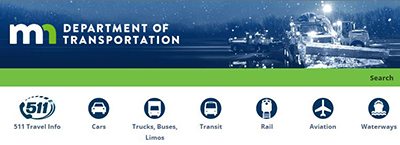
The new logo is now featured on most of MnDOT’s external webpages. |
Websites
Most external webpages now feature the new logo and brand. This includes a new top banner and updated fonts and colors. Some applications and older pages are still in transition. If the webteam has not contacted you about updating your pages, please email webteam.dot@state.mn.us.
Signs and buildings
The current guidance provided by the state logo team is to change signs bearing the old logo when the signs wear out. This includes the signs on our vehicles as well as on the many MnDOT buildings. As for the signs that are etched into stone or concrete, the plan is to leave them in place. While we are changing the logo, we are not discarding our past. Our history, the things we’ve learned and accomplished since the beginning of this agency, are what will help us move into the future. The old logo represents that history, and we are proud of it.
It will take time
The transition to the new logo will take some time. The goal is to be economical with time and resources and work towards the new brand during the next several months.
Questions
We will follow up with additional Newsline articles as more information becomes available. In the meantime, please contact webteam.dot@state.mn.us with questions.
Resources
Governor's branding site: http://mn.gov/portal/brand
Templates: http://ihub.dot.state.mn.us/communications/mndottemplates.html
Download logos: http://www.dot.state.mn.us/mediaroom/logos.html |
 |
|

|
 |
TABLE of CONTENTS
 |
MnDOT shares knowledge at national research conference |
By Micheal Foley, Research Services
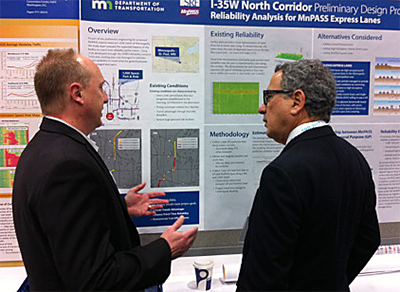
Brad Larsen (left), MnPASS Policy and Planning Program director, speaks with a conference attendee during a poster session this week at the Transportation Research Board Annual Meeting in Washington, D.C. Larsen was one of two dozen MnDOT employees invited to deliver presentations at the national transportation research event. Photo by Micheal Foley |
MnDOT employees are sharing knowledge and displaying leadership in Washington this week by delivering presentations and conducting meetings at the nation’s preeminent transportation conference.
The Transportation Research Board 96th Annual Meeting held Jan. 8-12 at the Walter E. Washington Convention Center in Washington, D.C., is expected to draw more than 12,000 transportation professionals from around the world. According to its website, the 2017 event scheduled more than 5,000 presentations in more than 800 sessions and workshops addressing topics of interest to policy makers, administrators, practitioners, researchers, and representatives of government, industry, and academic institutions. TRB’s 2017 annual meeting theme is “Transportation Innovation: Leading the Way in an Era of Rapid Change.”
“Every year when TRB holds its annual meeting, MnDOT’s strong presence at the event is a reminder of our state’s commitment to top-notch transportation research,” said Linda Taylor, director of MnDOT Research Services and Library.
The following is a roundup of MnDOT employees who were invited to deliver presentations and participate in key committee meetings (not all staff may have attended the conference due to limited funding or availability):
Commissioner Charlie Zelle; Ken Buckeye, Financial Management; Tom Burnham, Materials and Road Research; Katie Caskey, Transportation System Management; Shongtao Dai, Materials and Road Research; Dan Franta, District 7; Tim Henkel, Modal Planning and Program Management; Kyle Hoegh, Materials and Road Research; Bruce Holdhusen, Transportation System Management; Santiago Huerta, Metro District; Bernard Izevbekhai, Materials and Road Research; Tara Kalar, Chief Counsel; Brad Larsen, Metro District; Rita Lederle, Bridge Office; Francis Loetterle, Passenger Rail; Dean Mikulik, Materials and Road Research (student worker); Mark Nelson, Transportation System Management; Dave Solsrud, Modal Planning and Program Management; Trisha Stefanski, Modal Planning and Program Management; Linda Taylor, Transportation System Management; Joel Ulring, State Aid for Local Transportation; Jennifer Wells, Bridge Office, and Ben Worel, Materials & Road Research.
Editor’s note: For more information on the conference and the presentations by MnDOT employees, check out Micheal Foley’s blog.
|
 |
|

|
 |
TABLE of CONTENTS
 |
Metro’s Jack Pirkl celebrates 61-year career in transportation |
By R. Kent Barnard, Metro District communications and engagement
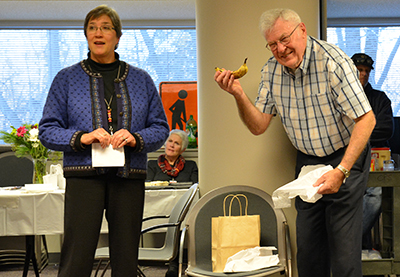
There was a lot of laughter at Jack Pirkl’s retirement ceremony Jan. 6. Sue Mulvihill, deputy commissioner/chief engineer, presented him with a gag gift, a typical “Pirkl lunch” consisting of a banana and some crackers. Photo by Rich Kemp |
As one of MnDOT’s longest-serving employees, Jack Pirkl, Metro District Bridge Maintenance, has seen profound changes in the transportation business. Pirkl retired this week after 61 years with the agency. Metro District staff gathered Jan. 6 to celebrate his dedicated years in construction and maintenance.
Pirkl joined the Minnesota Highway Department at the dawn of the nation’s interstate system and had a front row seat to much of the system’s creation in Minnesota and across the nation.
His first day on the job was June 13, 1955, as an 18-year-old high school graduate hired by the department as an engineering aide trainee. When he arrived for work at the resident office at Hwy 36 and Hwy 61, he was told he was going to be an inspector. From that informal beginning, Pirkl learned the basics of bridge construction on the job while helping build “bridge #6724,” the Hwy 36 bridge over Dale Street in Roseville.
It was at this point that the future bridge engineer found out he suffers from acrophobia, a fear of heights. His career continued, but bridge #6724 is now gone except for the original bridge plaque that was presented to him in 1999 when the bridge was replaced.
Pirkl also worked on the Hwy 100 Wakota bridge over the Mississippi River, now a portion of Interstate 494. Other projects included the interchange of Crosstown Hwy 62 and Cedar Avenue in Richfield, construction of concrete median barrier on I-94 in Minneapolis and St. Paul, and two bridge projects on the University of Minnesota campus.
During the late 1960s, Pirkl earned his engineering degree through a Minnesota Highway Department program that helped employees earn a civil engineering degree from the University of Minnesota. The program allowed employees to work only three-eighths of a regular work week to be paid a full 80-hour paycheck, and to bank overtime work hours. This helped him speed up his studies, graduate and receive his professional engineer registration in 1971.
Pirkl was a project engineer on the controversial I-35E project from 7th Street to Duke Street in St. Paul. The project was opposed for many years before the courts and the Legislature approved a modified parkway design banning heavy truck traffic and imposing a 45-mile per hour speed limit. He recalls the challenge of blasting hard limestone rock through the area to lower the interstate grade by seven feet at 7th Street.
Pirkl left the construction side of the business in 1974 for a position in bridge maintenance where he continued to serve the department until retiring Jan. 9. Asked what ranks among the biggest changes in his more than 60-year career, he is quick to cite changes in technology, technique and equipment.
“Trucks today are subject to fewer breakdowns and last much longer than 50 years ago,” said Pirkl. “Heavier traffic has also become the rule requiring a change in timing projects in the Twin Cities Metro area. Another change worth noting is the shift from hand levels and engineering slide rules to Global Positioning Systems and computers.”
Pirkl leaves this advice for MnDOT employees.
“One individual does not know everything,” said Pirkl. “The best advice sometimes comes from the new employee who has a new/modern approach to a situation/problem. All phases of MnDOT must work cohesively for the end result.”
What does he have planned after retirement?
“I really don’t have any big plans; been around the world already,” he said. “Been to China, Hong Kong, Sydney, Opryland, a safari and Europe six times. I will play some golf, enjoy some bowling, yard work and gardening.”
“It has been a long ride and I have finally come to the end.”
|
 |
|

|
 |
TABLE of CONTENTS
 |
Employees open their hearts during holidays to raise cash, gifts for their communities |
By Judy Jacobs
MnDOT employees across the state raised thousands of dollars for charities, contributed to Toys for Tots and Kids, donated food items and household goods, gave blood and showed some amazing holiday spirit.
Employee contributions include:
- District 1— Employees collected 36 toys and donated $200 in cash to the Salvation Army
- District 2 — Employees dedicated fundraising efforts to Addison Marjorie Aamodt (“Addie,” granddaughter of Randy Aamodt, Thief River Falls Bridge Office. Addie was born at 29 weeks with a variety of health concerns, including three holes in her heart, pulmonary hypertension, infantile spasms, moderate obstructive sleep apnea and Down syndrome. Addie already has undergone surgery to have a G-tube placed to help feed her. “She is one tough little girl who shows us how important each and every moment is,” said Addie’s parents, Mike and Alicia. (Mike is Randy’s son.) “Addison is our sweet, loving and resilient blessing.”

Addison Marjorie Aamodt, granddaughter of Randy Aamodt, Thief River Falls, Bridge Office. Photo courtesy of Mike and Alicia Aamodt |
A silent auction was held in the Bemidji headquarters office with all district employees invited to bid on numerous items donated by fellow employees, including a handmade wall hanging. Handmade ornaments for “Addie’s Tree” were also for sale in the Bemidji Headquarters and displayed in the front office.
Employees also donated cash during the holiday potluck in the Crookston and Bemidji headquarters.
Districtwide, these efforts raised $2,176 to help with Addie’s medical expenses.
- District 3 – St. Cloud office employees held their 10th annual holiday dinner and Toys for Tots fundraiser. These events raised $2,014 in cash donations–the most ever raised–and boxes of toys for children throughout the St. Cloud community.
At the Baxter headquarters office, employees gathered for a holiday potluck and Toys for Kids drive. This event raised $777 in cash donations and boxes of toys for children in the Brainerd Lakes area.
- District 4 – Employees raised $2,779 at their annual event to support Hospice of the Red River Valley. District employees first began raising funds for their local hospice in 1995 and to date have raised almost $30,000. “Everyone’s help is the key to this successful fundraiser,” said Trudy Kordosky, who coordinates the event with Jane Butzer and Jerimiah Moerke. “From setting up the room, to donating items for the drawing, bringing food for the potluck, monetary contributions–even cleaning up the room afterwards. Our employees really support this event.”
- District 6 – Six employees braved the cold Minnesota winter to participate in a local Polar Plunge, raising almost $3,000 to support local Special Olympics events. Rochester and Owatonna served as drop off points for Toys for Tots, and Winona participated in a similar program, to raise more than $1,000 in cash donations and dozens of toys and gifts.
-
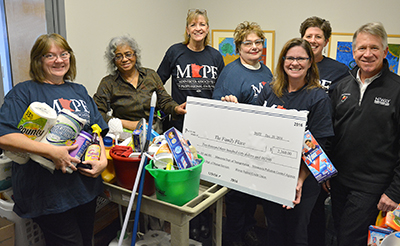
Employees from three MAPE locals presented more than $2,360 and cleaning supplies to the Family Place (from left to right) Nancy Stone, State Aid; Margret Lovejoy, Family Place executive director, Cheryl Hunstock, Office of Land Management; Deb Bergeron, MN.IT; Kim Nuckles, Pollution Control Agency; Melissa Wenzel, Pollution Control Agency; and Mark Hodowanic, Hiway Federal Credit Union. Photo by Rich Kemp |
District 7 – Employees contributed non-perishable food items to the AFSCME Council 5 food drive to go to the Echo Food Shelf and partnered with Minnesota State Patrol District 2200 to collect toys for the local Toys for Tots campaign.
- Central Office in St. Paul – Employees worked with MAPE Locals 201, 301 and 801 to raise funds and cleaning supplies for The Family Place, a safe place for homeless families in Ramsey County to stay while they await transition to permanent housing. More than $2,300 was raised and more than a dozen laundry baskets of supplies were donated. Read the complete story at www.mape.org/mape/news/brighter-holidays-homeless-families.
- A Giving Tree in the reception area at Central Office also sported hats and mittens to be donated to a local homeless shelter.
- The Bridge Office adopted a soldier—actually, a platoon of 10 soldiers. They shipped nine boxes of goods that employees donated to Project Frontlines with Adopt a US soldier. There were multiples of everything on the list to support the 10 people serving in Afghanistan. In addition, a silent auctions was held where almost $700 was raised to donate to a local food bank and to cover shipping costs for seven boxes of goodies to the soldiers.
|
 |
|

|
 |
TABLE of CONTENTS
 |
How are WIG 1.0 and WIG 2.0 connected? |
By Tracy Hatch, deputy commissioner, chief financial officer and chief operating officer
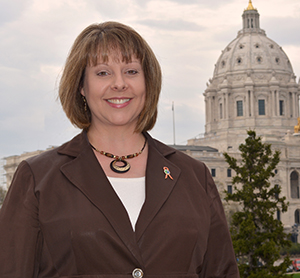
Tracy Hatch is MnDOT's deputy commissioner, chief operating officer and chief financial officer. Photo by Rich Kemp |
A question we often get is, “How is WIG 2.0 – Earning Customer Trust connected to WIG 1.0 – Enhancing Financial Effectiveness?” This is such a great question!
The answer to that question is: When we enhance financial effectiveness, we also earn customer trust. WIG 1.0 set the foundation for MnDOT to be able to take on a second Wildly Important Goal around earning customer trust. The four major projects, or “battles,” in WIG 1.0 were: asset management, financial management, project management, and information and outreach. None of these were new concepts for MnDOT – they are all topics that had been explored and worked on for many years. Senior leadership felt we needed to have these major foundational areas solidified before taking on something new.
WIG 1.0 took a new approach to tackling these critical areas. By using the 4 Disciplines of Execution and project management principles, MnDOT was able to execute our most strategic priorities. We pulled these areas out of our day-to-day “whirlwind” and gave them resources and special attention for two-plus years, and developed systems to better manage them on an ongoing basis. The return on investment for this effort will be great for many years to come and build a strong foundation for an improved way of doing business.
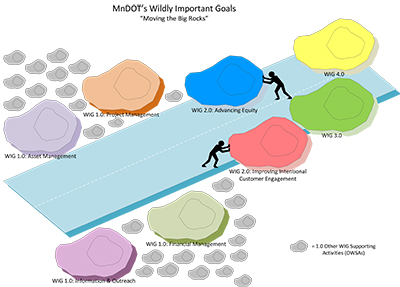
This graphic shows MnDOT’s progress on priorities selected for Wildly Important Goals over time. Using the 4 Disciplines of Execution we work together with a shared focus on a specific goal (represented by the rocks), one WIG at a time. Over time, we move the improvements we make back into our day-to-day whirlwind. As we accomplish our shared goals, we clear the “road” for a smoother journey with more innovation, efficient processes, projects, products, and ultimately better performance and quality of life in Minnesota. Graphic created by Jocelyn Stein and AnneMarie Burgess |
These improvements gave us data we didn’t previously have, giving credibility to our decision-making. It also helped us answer questions from our stakeholders. WIG 1.0 helped us to be more effective in demonstrating our use of taxpayer-provided resources.
Earning Customer Trust builds on what we’ve created in Enhancing Financial Effectiveness so we can continue our path of improvements. Our desired outcome for 1.0 was to:
Earn or reinforce stakeholder trust and confidence in MnDOT by demonstrating effective and efficient stewardship of public resources.
And our desired outcome for 2.0 is:
MnDOT will earn trust and increase transparency through a customer-centered organization in which we engage customers, listen to understand and balance the diverse needs of all to achieve the best possible outcomes.
Senior leadership intentionally chose similar language so 2.0 naturally builds on the successes of 1.0. Earning trust is a theme woven into both MnDOT’s first two WIGs. “Earning trust” is not suggesting we’ve lost trust (see my recent Newsline article) but rather that we’re on a constant journey to earn trust with the public, key stakeholders (MnDOT’s external customers) and with each other (internal customers) so we can consistently deliver our mission to:
Plan, build, operate and maintain a safe, accessible, efficient and reliable multimodal transportation system that connects people to destinations and markets throughout the state, regionally and around the world.
And achieve our vision, whereby:
Minnesota’s multimodal transportation system maximizes the health of people, the environment and our economy.
Customer survey results
The agency-wide WIG customer survey results are in: MnDOT staff were rated an average of 5.1 on a 6-point scale for providing information and services respectfully (defined as warm, friendly and inviting tone) by both external and internal customers.
Overall experience satisfaction rating by customers was approximately 80.5 percent (either a good, very good or excellent rating for their most recent experience).
Congratulations and great job, everyone!
Additional survey results and "A to B by When" improvement goals informed by the survey will be announced later this month for the Improve Intentional Customer Engagement priority of the WIG 2.0 Framework.
Winners of the friendly competition challenge for the final survey push will be announced later this week. |
|
 |
|

|
|
| |
|



